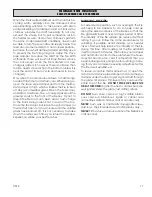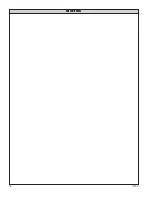
3
USSC
CHIMNEY REQUIREMENTS
A fireclay lined masonry or Class A 103HT All-Fuel Metal
Insulated Chimney must be used in all airtight wood fur
-
nace installations. The minimum recommended flue size
for the model 1602 is 6 inches, inside diameter. When mak
-
ing new chimney installations, always follow the chimney
manufacturer’s instructions.
If at all possible, use the factory built, class A 103HT chim
-
ney mentioned above. They are safer and perform better
than traditional masonry chimneys. If a masonry chimney
is a must, be certain it has a fire clay liner and that it is
intact, clean and recently inspected. And remember,
masonry chimneys are far more prone to the formation of
hazardous creosote.
1. The furnace should be the only heating using the
chimney flue . One furnace per flue outlet.
2. A masonry chimney should have a tile or stainless steel
liner.
3. The masonry chimney should not have any missing
mortar or loose bricks.
4. There should be no mortar or parts of the chimney
blocking the chimney flue.
5. There should be a two inch clearance between any
chimney (masonry or metal) and combustibles. (such
as the house)
6. The chimney should extend at least 2 foot above the
highest point of the house, or 2 foot above the point at
which the chimney is 10 foot from the roof.
7. The chimney should be relatively straight and vertical.
8. The portion of an all-fuel metal chimney that extends
above the roof should be well secured.
9. A masonry chimney should be built on footings and
not attached to the house.
10. A rain cap, complete with an animal or bird screen,
should be installed on top of the chimney.
CREOSOTE - FORMATION AND NEED
FOR REMOVAL
When wood is burned slowly, it produces tar and other
organic vapors, which combine with expelled moisture to
form creosote. The creosote vapors condense in the rela
-
tively cool chimney flue of a slow-burning fire. As a result,
creosote residue accumulates on the flue lining. When
ignited, this creosote makes an extremely hot fire.
The chimney connector and chimney should be inspected
at least twice monthly during the heating season to deter
-
mine if a creosote build-up has occurred. If creosote has
accumulated, it should be removed to reduce the risk of
a chimney fire.
SMOKE PIPE INSTALLATION
Clearances to combustible materials (i.e. paneling, ceil
-
ing tile, sheet rock, plaster, draperies, casements or wood
trim, etc.) will vary with the type of flue connection used.
Be sure to maintain the specified clearances for your type
of installation.
TYPE OF FLUE
REQUIRED
CONNECTION
CLEARANCE
24 Gauge or Heavier ..................................18”
Single Wall Stainless Steel
or Black Pipe
Double Wall, Stainless Steel or ....................6”
Double Wall, Black Pipe w/
Stainless Steel Inner wall
Class A 103HT All-Fuel or Equivalent ..........2”
According to NFPA standards, single wall stove pipes
can be within 9” of combustibles provided an approved
fire retardant material covered with 28 gauge sheet
metal, spaced out 1” on non-combustible spacers, is
utilized. See illustration.
When using a Class A or double wall flue pipe connection,
follow the manufacturer’s instructions.
When constructing a single wall smoke pipe, the following
guidelines must be observed.
1. The connector pipe should be 24 gauge or heavier
stainless steel or black pipe.
2. Secure all joints with three #8 screws.
3. If the connector pipe must pass through a wall, an ap
-
proved insulated or ventilated thimble, at least three
times the diameter of the smoke pipe must be used.
(i.e. a 6” diameter smoke pipe needs an 18” thimble).
4.
The connector pipe should never be used as a chimney.
Summary of Contents for NITED STATES STOV 1602M
Page 18: ...18 USSC NOTES ...
Page 19: ...19 USSC NOTES ...




































